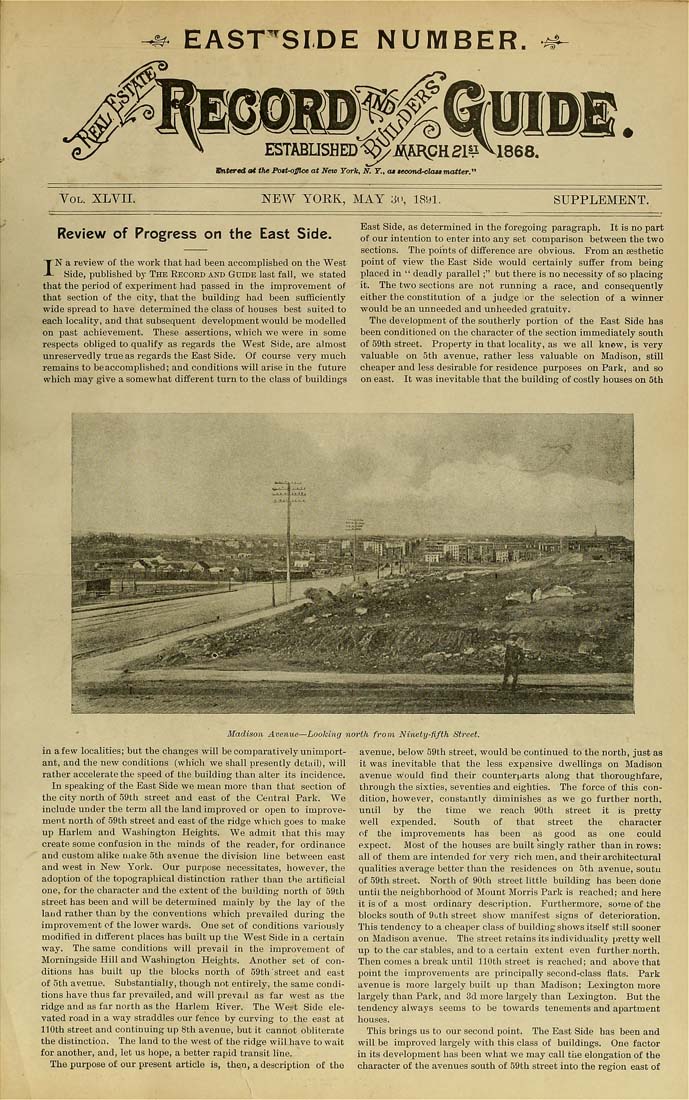Please note: this text may be incomplete. For more information about this OCR, view
About OCR text.
EAST^'SLDE NUMBER.
ESTABLISHED '^ J8VARpH£l^Xl868,
@mm.
Wntertd at the Foit-offlee at New Tork, N. T., at $eoond-claumatter."
Vol. XLVII.
NEW YOEK, MAY Jo, 18yl.
SUPPLEMENT.
Review of Progress on the East Side.
IN a review of the work that had been accomplished on the West
Side, published by The Record and Guide last fall, we stated
that the period of experiment liad passed in the improvement of
that section of the city, that the building had been sufficiently
wide spread to have determined the class of houses best suited to
each locality, and that subsequent development would be modelled
on past achievement. These assertions, which we were in some
respects obliged to qualify as regards the West Side, are almost
unreservedly true as regards the East Side. Of course very much
remains to bea.ccomplished; and conditions will arise in the future
wbich may give a somewhat different turn to the class of buildings
East Side, as determined in the foregoing paragraph. It is no part
of our intention to enter into auy set comparison between the two
sections. The points of difference are obvious. From au sesthetic
point of view the East Side would certainly suffer from being
placed in " deadly parallel;" but there is no necessity of so placing
it. The fcwo sections are not running a race, and consequently
either the constitution of a judge or the selection of a winner
would be an unneeded and unheeded gratuitv.
The development of the southerly portion of the East Side has
been conditioned on the character of the section immediately south
of 59th street. Property in that locality, as we all know, is very
valuable on Sth avenue, rather less valuable on Madison, still
cheaper and less desirable for residence purposes on Park, and so
on east. It was inevitable that the building of costly houses on Sth
Madison Auenue—Looking north from Ninety-fifth Street.
ia afew localities; but the changes will be comparatively unimport¬
ant, aud the new conditions (which we shall presently detail), will
rather accelerate the speed of the building tban alter its incidence.
In speaking of the East Side we mean more tban that section of
the city north of 59th sireet and east of the Central Park, We
include under the tei-m all the land improved or open to improve¬
ment north of 59th street and east of the ridge which goes to make
up Harlem and Washington Heights. We admit that this may
create some confusion in t\w minds of the reader, for ordinance
and custom alike make Sth avenue the division line between east
and west in New York. Our purpose necessitates, however, the
adoption of the topographical distinction rather than the artificial
one, for the character and the extent of the building north of 59th
street has been and will be determined mainly by the lay of the
land rather than by the conventions which prevailed during tbe
improvement of the lower wards. Oue set of conditions variously
modified in different places has built up tlie West Side in a certain
way. The same conditions will jH-evail in the improvement of
Morningside Hill and Washiugtou Heigbts. Another set of con¬
ditions has built up the blocks north of 59th street and east
of Sth aveaue. Substantially, though not entirely, the same condi¬
tions have thus far prevailed, and will prevail as far west as the
ridge and as far uorth as the Harlem River. The West Side ele¬
vated road in a way straddles our fence by curving to the east at
noth street and continuing up 8th avenue, but it cannot obliterate
tbe distinctiOD, The land to the west of the ridge will have to wait
for another, and, let us hope, a better rapid transit line.
The purpose of our present article is, then, a description of the
avenue, below 59th street, would be continued to the north, just as
it was inevitable that the less expansive dwellings on Madison
avenue would find their counterparts along that thoroughfare,
through tbe sixties, seventies and eighties. The force of tliis con¬
dition, however, constantly diminishes as we go further north,
until by the time we reach BOth street it is pretty
well expended. South of that street the character
of the improvements has been as good as one could
espect. Most of the houses are built singly rather than in rows;
all of them are intended for very rich men, and their architectm'al
qualities average better thau the residences on 5th avenue, soutn
of 59 th street. Northof 90th street little building has been done
until the neighborhood of Mount Morris Park is reached; and here
it is of a most ordinary description. Furthermore, some of the
blocks south of 9ijth street show manifest signs of deterioration.
This tendency to a cheaper class of building shows itself still sooner
on Madison avenue. The street retains its individualiej- pretty well
up to the car stables, and to a certain extent even further north.
Theu comes a break until 110th street is reached; and above that
point tlie improveraents are principally second-class flats. Park
avenue is more largely built up than Madison; Lesington more
largely than Park, and 3d more largely than Lesington. But the
tendency always seems to be towards tenements and apartment
houses,
This brings us to our second jjoint. The East Side has been and
will be improved largely with this class of buildings. One factor
in its development has been what we may call the elongation of the
character of the avenues south of 59fch street into the region east of








